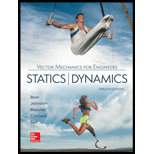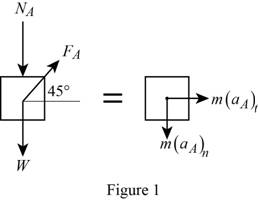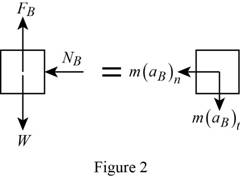
A 10-lb collar is attached to a spring and slides without friction along a fixed rod in a vertical plane. The spring has an undeformed length of 14 in. and a constant k = 4 lb/in. Knowing that the collar is released from rest in the position shown, determine the force exerted by the rod on the collar at (a) point A, (b) point B. Both these points are on the curved portion of the rod.
Fig. P13.73

(a)
Find the force exerted by the rod on the collar at A (NA).
Answer to Problem 13.73P
The force exerted by the rod on the collar at A (NA) is 82.4lb_.
Explanation of Solution
Given information:
The weight of the collar (W) is 10 lb.
The un-deformed length (l0) is 14in.
The spring constant (k) is 4lb/in.
The length of top support to point A (lA) is 14in.
The length of point A to point B (lAB) is 14in.
The horizontal distance from weight to point A (x1) is 14in.
The horizontal distance from point A to point B (x2) is 14in.
The acceleration due to gravity (g) is 32.2ft/s2.
Calculation:
Calculate the mass of the collar (m) using the relation:
W=mgm=Wg
Substitute 10 lb for W and 32.2ft/s2 for g.
m=1032.2=0.31056lb⋅ft/s2
Consider the position 1.
Calculate the length from weight to point B (l1) using the relation:
l1=√(x1+x2)+(lA)2
Substitute 14in. for x1, 14in. for x2, and 14in. for l1.
l1=√(14+14)2+(142)=31.305in.
Calculate the stretch in rod (s1) at position 1 using the relation:
s1=l1−l0
Substitute 31.305in. for l1 and 14in. for l0.
s1=31.305−14in.=17.305in.
Here, the kinetic energy at position 1 (T1) is zero.
Calculate the potential energy in the position 1 due to elongation of the rod (V1)e using the relation:
(V1)e=12ks21
Substitute 4lb/in. for k and 17.305in. for s1.
(V1)e=12×4×(17.3052)=598.9261 lb⋅in.×112(ftin.)=49.910 lb⋅ft
Here, the potential energy in the position 1 due to gravitation of the rod (V1)g is zero.
Calculate the total potential energy (V1) using the relation:
V1=(V1)e+(V1)g
Substitute 49.910 lb⋅ft for (V1)e and 0 for (V1)g.
V1=49.910 lb⋅ft+0=49.910 lb⋅ft
Consider the position A.
Calculate the length at point A (lA) using the relation:
lA=√(x1)+(lA)2
Substitute 14in. for x1 and 14in. for lA.
lA=√(14)2+(142)=19.799in.
Calculate the stretch in rod (sA) at position A using the relation:
sA=lA−l0
Substitute 19.799in. for lA and 14in. for l0.
sA=19.799−14in.=5.799in.
Calculate the kinetic energy at position A (TA) using the formula:
TA=12mv2A
Here, vA is the velocity in the position A.
Substitute 0.31056lb⋅ft/s2 for m.
TA=12(0.31056lb⋅ft/s2)v2A=0.15528v2A
Calculate the potential energy in the position A due to elongation of the rod (VA)e using the relation:
(VA)e=12ks2A
Substitute 4lb/in. for k and 5.799in. for sA.
(VA)e=12×4×(5.7992)=67.257 lb⋅in.×112(ftin.)=5.605 lb⋅ft
Here, the potential energy in the position 1 due to gravitation of the rod (V1)g is zero in the datum at level A.
Calculate the total potential energy (VA) in position A using the relation:
VA=(VA)e+(VA)g
Substitute 5.605 lb⋅ft for (VA)e and 0 for (VA)g.
VA=5.605 lb⋅ft+0=5.605 lb⋅ft
The expression for principle for conservation of energy as follows;
T1+V1=TA+VA
Substitute 0 for T1, 49.910 lb⋅ft for V1, 0.15528v2A for TA and 5.605 lb⋅ft for VA.
0+49.910 lb⋅ft=0.15528v2A+5.605 lb⋅ft0.15528v2A=49.910−5.6050.15528v2A=44.305v2A=44.3050.15528v2A=285.3233ft/svA=√285.3233vA=16.892ft/s
Show the free body diagram of the point A with the forces acting as in Figure (1).

Calculate the normal acceleration at position A (aA)n using the formula:
(aA)n=v2Aρ
Substitute 285.3233ft/s for v2A and 14in. for ρ.
(aA)n=285.323314in.×112ftin.=244.56ft/s2
Calculate the spring force at position A (FA) using the formula:
FA=ksA
Substitute 4lb/in. for k and 5.799in. for sA.
FA=4(5.799)=23.196lb
Calculate the angle (α) using the relation:
tanα=lAx1
Substitute 14in. for x1 and 14in. for lA.
tanα=1414α=tan−1(1414)α=45°
Calculate the force exerted by the rod on the collar in the point A (NA) by considering the Newton’s second law:
∑F=m(aA)nNA+W−FAsinα=m(aA)n
Substitute 10 lb for W, 23.196lb for FA, 45° for α, 0.31056lb⋅ft/s2 for m and 244.56ft/s2 for (aA)n.
NA+10−(23.196×sin45°)=(0.31056×244.56)NA+10−16.40205=75.951NA=75.951−10+16.40205NA=82.4lb
Therefore, the force exerted by the rod on the collar at A (NA) is 82.4lb_.
(b)
Find the force exerted by the rod on the collar at B (NB).
Answer to Problem 13.73P
The force exerted by the rod on the collar at B (NB) is 49.6lb_.
Explanation of Solution
Given information:
The weight of the collar (W) is 10 lb.
The un-deformed length (l0) is 14in.
The spring constant (k) is 4lb/in.
The length of top support to point A (lA) is 14in.
The length of point A to point B (lAB) is 14in.
The horizontal distance from weight to point A (x1) is 14in.
The horizontal distance from point A to point B (x2) is 14in.
The acceleration due to gravity (g) is 32.2ft/s2.
Calculation:
Consider the position B.
Calculate the length at point B (lB) using the relation:
lB=x1+x2
Substitute 14in. for x1 and 14in. for x1.
lB=14+14=28in.
Calculate the stretch in rod (sB) at position B using the relation:
sB=lB−l0
Substitute 28in. for lB and 14in. for l0.
sB=28−14in.=14in.
Calculate the kinetic energy at position B (TB) using the formula:
TB=12mv2B
Here, vB is the velocity in the position B.
Substitute 0.31056lb⋅ft/s2 for m.
TB=12(0.31056lb⋅ft/s2)v2B=0.15528v2B
Calculate the potential energy in the position B due to elongation of the rod (VB)e using the relation:
(VB)e=12ks2B
Substitute 4lb/in. for k and 14in. for sB.
(VB)e=12×4×(142)=6392 lb⋅in.×112(ftin.)=32.667lb⋅ft
Calculate the potential energy in the position B due to gravitation of the rod (VB)g using the relation:
(VB)g=Wl0
Substitute 10lb for W and −14in. for l0.
(VB)g=10(−14)=−140 lb⋅in.×112(ftin.)=−11.667 lb⋅ft
Calculate the total potential energy (VB) in the position B using the relation:
VB=(VB)e+(VB)g
Substitute 32.667lb⋅ft for (VB)e and −11.667 lb⋅ft for (VB)g.
VB=32.667lb⋅ft−11.667 lb⋅ft=21.0lb⋅ft
The expression for principle for conservation of energy as follows;
T1+V1=TB+VB
Substitute 0 for T1, 49.910 lb⋅ft for V1, 0.15528v2B for TB and 21.0lb⋅ft for VB.
0+49.910 lb⋅ft=0.15528v2B+21.0lb⋅ft0.15528v2B=49.910−210.15528v2B=28.91v2B=28.910.15528v2B=186.18ft/svB=√186.18vB=13.645ft/s
Show the free body diagram of the point B with the forces acting as in Figure (2).

Calculate the normal acceleration at position b (aB)n using the formula:
(aB)n=v2Bρ
Substitute 186.18ft/s for v2B and 14in. for ρ.
(aB)n=186.1814in.×112ftin.=159.583ft/s2
Calculate the spring force at position B (FB) using the formula:
FB=ksB
Substitute 4lb/in. for k and 14in. for sB.
FB=4(14)=56 lb
Calculate the force exerted by the rod on the collar in the point B (NB) by considering the Newton’s second law:
∑F=m(aB)nNB=m(aB)n
Substitute 0.31056lb⋅ft/s2 for m and 159.583ft/s2 for (aB)n.
NB=(0.31056×159.583)=49.6lb
Therefore, the force exerted by the rod on the collar at B (NB) is 49.6lb_.
Want to see more full solutions like this?
Chapter 13 Solutions
VECTOR MECHANICS FOR ENGINEERS W/CON >B
- PROBLEM 3.46 The solid cylindrical rod BC of length L = 600 mm is attached to the rigid lever AB of length a = 380 mm and to the support at C. When a 500 N force P is applied at A, design specifications require that the displacement of A not exceed 25 mm when a 500 N force P is applied at A For the material indicated determine the required diameter of the rod. Aluminium: Tall = 65 MPa, G = 27 GPa. Aarrow_forwardFind the equivalent mass of the rocker arm assembly with respect to the x coordinate. k₁ mi m2 k₁arrow_forward2. Figure below shows a U-tube manometer open at both ends and containing a column of liquid mercury of length l and specific weight y. Considering a small displacement x of the manometer meniscus from its equilibrium position (or datum), determine the equivalent spring constant associated with the restoring force. Datum Area, Aarrow_forward
- 1. The consequences of a head-on collision of two automobiles can be studied by considering the impact of the automobile on a barrier, as shown in figure below. Construct a mathematical model (i.e., draw the diagram) by considering the masses of the automobile body, engine, transmission, and suspension and the elasticity of the bumpers, radiator, sheet metal body, driveline, and engine mounts.arrow_forward3.) 15.40 – Collar B moves up at constant velocity vB = 1.5 m/s. Rod AB has length = 1.2 m. The incline is at angle = 25°. Compute an expression for the angular velocity of rod AB, ė and the velocity of end A of the rod (✓✓) as a function of v₂,1,0,0. Then compute numerical answers for ȧ & y_ with 0 = 50°.arrow_forward2.) 15.12 The assembly shown consists of the straight rod ABC which passes through and is welded to the grectangular plate DEFH. The assembly rotates about the axis AC with a constant angular velocity of 9 rad/s. Knowing that the motion when viewed from C is counterclockwise, determine the velocity and acceleration of corner F.arrow_forward
 Elements Of ElectromagneticsMechanical EngineeringISBN:9780190698614Author:Sadiku, Matthew N. O.Publisher:Oxford University Press
Elements Of ElectromagneticsMechanical EngineeringISBN:9780190698614Author:Sadiku, Matthew N. O.Publisher:Oxford University Press Mechanics of Materials (10th Edition)Mechanical EngineeringISBN:9780134319650Author:Russell C. HibbelerPublisher:PEARSON
Mechanics of Materials (10th Edition)Mechanical EngineeringISBN:9780134319650Author:Russell C. HibbelerPublisher:PEARSON Thermodynamics: An Engineering ApproachMechanical EngineeringISBN:9781259822674Author:Yunus A. Cengel Dr., Michael A. BolesPublisher:McGraw-Hill Education
Thermodynamics: An Engineering ApproachMechanical EngineeringISBN:9781259822674Author:Yunus A. Cengel Dr., Michael A. BolesPublisher:McGraw-Hill Education Control Systems EngineeringMechanical EngineeringISBN:9781118170519Author:Norman S. NisePublisher:WILEY
Control Systems EngineeringMechanical EngineeringISBN:9781118170519Author:Norman S. NisePublisher:WILEY Mechanics of Materials (MindTap Course List)Mechanical EngineeringISBN:9781337093347Author:Barry J. Goodno, James M. GerePublisher:Cengage Learning
Mechanics of Materials (MindTap Course List)Mechanical EngineeringISBN:9781337093347Author:Barry J. Goodno, James M. GerePublisher:Cengage Learning Engineering Mechanics: StaticsMechanical EngineeringISBN:9781118807330Author:James L. Meriam, L. G. Kraige, J. N. BoltonPublisher:WILEY
Engineering Mechanics: StaticsMechanical EngineeringISBN:9781118807330Author:James L. Meriam, L. G. Kraige, J. N. BoltonPublisher:WILEY





